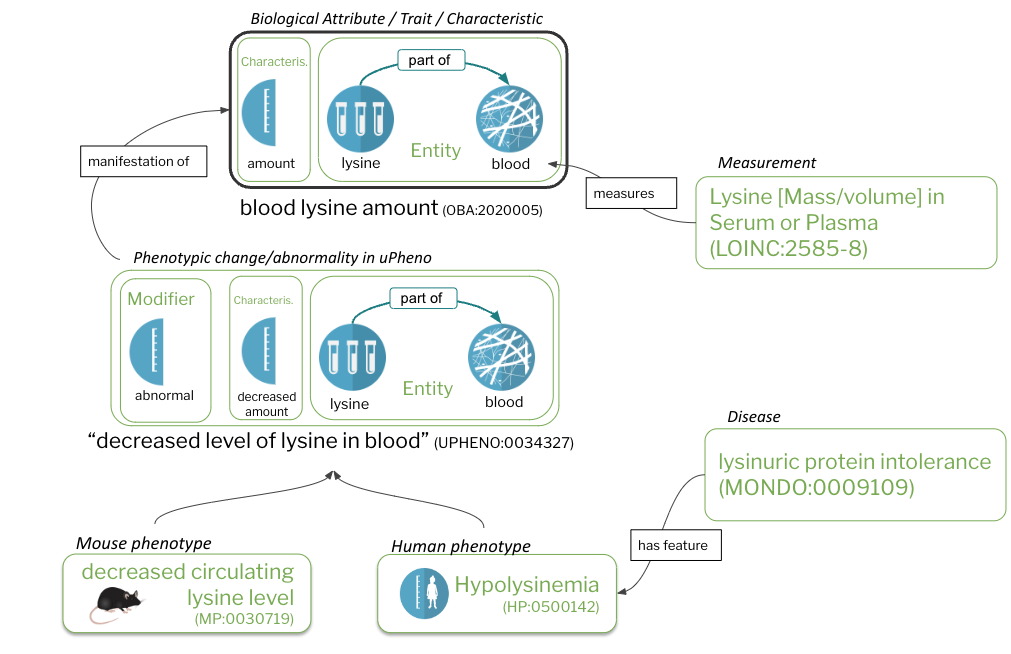Basic concepts of phenotype data and ontologies
Basic concepts of phenotype data integration¶
Part of the Phenotype data and the role of ontologies" (OBO Academy Phenomics Series).
Authors:
Last update: 30.03.2024.
In this lesson, we will discuss:
- Core concepts, from characteristics and biological attributes to phenotypic abnormalities
- Different types of phenotype data capture in practice
- An overview on how the uPheno framework supports integrating all kinds of phenotype data into a computational framework
- A brief outlook and how computational phenotypes can be exploited for analysis

Overview¶
Phenotyping is, in essence, the process of recording the observable characteristics, or phenotypic profile, of a subject. There are many use cases for doing this task, for example:
- Clinicians have to record a patient's phenotypic profile to facilitate more accurate diagnosis
- Researchers have to record phenotypic profiles of model organisms to characterise them and assess interventions (genetic or drug or otherwise).
- Curators extract knowledge from scientific publications to build knowledge bases which contain associations between phenotypes and other data types.
There are different schools and use cases that are concerned with how to record phenotypes in a structured manner:
- Quantified phenotypes can be recorded as a trait in combination with a measurement datum (“head circumference”, “35 cm”) or a qualified term expressing “phenotypic change” (“increased head circumference”).
- We can express phenotype terms as “pre-coordinated” terms, like “increased head circumference” or a “post-coordinated expression”, like “head”, “circumference”, “increased”).
- Phenotype data can be standardised to varying degrees, from free text to ontology terms.
In this lesson, we will introduce different concepts and categories around phenotype data, and provide an introduction on how to integrate them using the uPheno framework.
Prerequisites¶
- Basic understanding of ontologies.
- Basic understanding of structured data.
Preparation¶
None.
What is delivered as part of the course¶
- A basic understanding of the core concepts around phenotype data, from characteristics, measurements and traits to phenotypic abnormalities and diseases.
- A basic understanding of how the uPheno framework integrates such data.
Table of contents¶
- Core concepts
- Phenotype Data in practice
- Integrating phenotype data
- The promise of integrated, computational phenotype data
Recording¶
This is a recording from April 2024 covering the entire course:
Core concepts¶
Duration: 12 min
Goals of this section:
- Give a sense of the core features of phenotype data, including characteristics, traits and abnormalities.
- Materials.
Phenotype Data in practice¶
Duration: 12 min
Goals of this section:
- Give a sense of the contexts in which phenotype data is produced (research and clinical)
- Give a sense of the shape of different styles of phenotype data
- Materials.
Integrating phenotype data¶
Duration: 12 min
Goals of this section:
- Show how the uPheno framework can be used to translate many forms of phenotype data into a coherent computational framework.
- Show how the uPheno framework can be enriched with knowledge about phenotypes.
- Materials.
The promise of integrated, computational phenotype data (4 min)¶
Duration: 4 min
Goals of this section:
- Give a sense how the uPheno framework can be used computationally.
- Materials.
